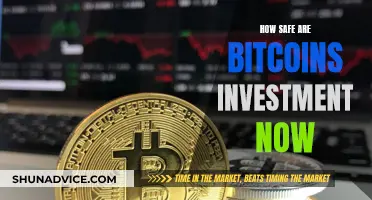
Silver and Bitcoin are vastly different assets that serve different purposes in an investor's portfolio. Silver is a precious metal that has been used as a form of money and a store of value for thousands of years. On the other hand, Bitcoin is a decentralized digital currency that was introduced in 2009 and has gained widespread recognition since then.
Silver is often seen as a safe-haven asset and a hedge against inflation. It is a tangible asset that is expected to hold its value over the long term. However, investing in silver bullion comes with risks such as the danger of theft, high premiums during high demand, and lack of liquidity.
Bitcoin, being a relatively new asset, is highly volatile and subject to media influence, investor sentiment, and regulatory actions. It offers high liquidity and massive gain potential but also carries the risk of massive losses.
Both silver and Bitcoin have their pros and cons, and the decision to invest in either depends on various factors such as risk tolerance, investment goals, and strategy.
| Characteristics | Silver | Bitcoin |
|---|---|---|
| Accessibility | Significantly cheaper than gold, making it more accessible for investors. | Requires a high level of technical knowledge to understand and invest. |
| Volatility | Silver is volatile but can provide a cushion against declines in purchasing power over the long term. | Highly volatile. |
| Liquidity | Silver bullion coins are not legal tender, so they can't be used for everyday purchases. | High liquidity once a cryptocurrency's base is well-established. |
| Returns | Silver has outperformed gold in bull markets. | Offers massive gain potential, but also carries the risk of massive losses. |
| Safety | Silver is vulnerable to theft if held at home. | Bitcoin is vulnerable to theft by hackers. |
| Industrial Applications | Silver has industrial applications in electronics, automobiles, mirrors, water purifiers, solar panels, and electric vehicles. | Bitcoin has limited utility as it is currently only used as a digital currency and a speculative investment. |
What You'll Learn

Silver's industrial applications
Silver has a wide range of industrial applications, which account for more than half of the annual demand worldwide. Its physical strength, brilliance, malleability, and ductility make it a popular material for jewellery, tableware, and fine art. However, its industrial applications focus on its conductivity, sensitivity to light, and antibacterial qualities.
Silver is used in electrical switches, solar panels, and chemical-producing catalysts. Its high electrical conductivity and durability make it ideal for coating electrical contacts in printed circuit boards and RFID chips. Its antibacterial properties make it useful in medicine and water purification. Silver is also used in batteries, dentistry, glass coatings, LED chips, nuclear reactors, photography, semiconductors, touch screens, and wood preservatives.
In 2022, global physical silver demand reached a record high of 1.242 billion ounces. This demand is expected to increase due to the push toward renewable energy, vehicle electrification, the adoption of 5G technologies, and the solar energy sector. Silver is a key component in solar panels, and its use in this industry is expected to grow rapidly in the short to medium term.
The biggest consumers of silver for industrial applications over the past decade have been the US, Canada, China, India, Japan, South Korea, Germany, and Russia.
Building Bitcoin City: A Guide to Investing
You may want to see also

Silver's value as a tangible asset
Silver has been valued as a tangible asset for several reasons. Firstly, it is a precious metal that has been sought after for thousands of years, often for use in currency and jewellery. Silver is also a tangible asset that can be physically held and stored, and its value is less depreciable as it cannot be created artificially but only sourced from the earth.
Silver has been recognised as a store of value for over 6,000 years, and its value is expected to remain stable even during economic downturns. Silver's value is also less prone to depreciation as it is not subject to the same risks of bankruptcy or default as other investment options like stocks or bonds.
Silver has practical applications beyond its use as an investment, particularly in the technology industry. For example, silver is used in solar panels and computer devices due to its electrical conductivity. This intrinsic value ensures that silver is likely to retain its worth even during economic downturns.
Additionally, silver is a good hedge against inflation. As the purchasing power of the dollar declines, the value of silver tends to increase, making it an attractive investment option for those seeking to protect their wealth.
Finally, silver is a more affordable investment option compared to other precious metals like gold, making it accessible to a wider range of investors.
Is Bitcoin a Safe Investment?
You may want to see also

Bitcoin's liquidity
Liquidity is a key consideration when deciding whether to invest in silver or bitcoin. Bitcoin is a highly liquid asset, but its liquidity depends on the platform used to trade it. For example, Coinbase only allows for $100,000 liquidation of cryptocurrency per day. If Bitcoin's price is higher than this daily limit, it will need to be liquidated in smaller increments.
On the other hand, bitcoin has a higher liquidity than silver due to its digital nature. Silver, being a physical asset, may be subject to higher premium costs due to mining, refining, transportation, storage, and dealer fees.
Overall, bitcoin's liquidity makes it a highly speculative investment, while silver's stability and universal value make it a more secure long-term investment.
Why Bitcoin Belongs in Your Investment Portfolio
You may want to see also

Bitcoin's volatility
Bitcoin is considered a volatile asset. Volatility is a measure of how much the price of a financial asset varies over time. It is a measure of the risk of holding an asset, as it may substantially increase or decrease in value.
Bitcoin's high volatility means that it is a risky investment. However, investors have historically been well compensated for this risk, with Bitcoin's high volatility resulting in high returns.
Bitcoin's Meteoric Rise: Unlocking Life-Changing Wealth
You may want to see also

Silver's demand and supply
Supply:
- Silver is classified as a ""precious metal"" due to its unique characteristics and relative scarcity.
- The supply of silver is limited, but it is not as rare as gold. Gold is present at four parts per billion in the Earth's crust, while silver is found at 75 parts per billion.
- Silver is obtained through mining, and its supply can be impacted by factors such as production costs, mining interruptions, and the discovery of new uses or technologies that utilise silver.
Demand:
- Silver has constant demand due to its diverse applications and recognition as a valuable commodity.
- Silver is used in industrial and commercial applications, such as dentistry, electronics, solar panels, and photography (although the demand from photography has decreased with the shift to non-silver-based processes).
- The demand for silver jewellery and luxury items is often linked to economic trends and the health of the economy, particularly in emerging markets.
- Silver is also considered a "safe haven" investment during economic uncertainty, as it retains its value and purchasing power better than paper currency.
- The price of silver tends to track the performance of the overall stock market and the economy. During economic expansions, silver prices usually rise, while they fall during recessions.
- The strength of the US dollar has an inverse relationship with silver prices. A strong dollar can create downward pressure on silver prices.
- Government policies and actions, such as central bank purchases or sales of silver bullion, can also influence the market.
In summary, the interplay between the supply and demand for silver drives its value. Investors should consider these factors when evaluating the potential for investing in silver, along with their own risk tolerance and investment goals.
The Ultimate Investment: Bigger Than Bitcoin?
You may want to see also
Frequently asked questions
Silver can provide a hedge against inflation, acting as a store of value. It is a tangible asset that is easy to transfer and has universal value. Silver also has multiple uses and demand for it will always exist.
Silver is vulnerable to theft and may not perform as well as other investments. It also has high premiums and lacks liquidity.
Bitcoin has high liquidity and can be accessed from anywhere. It also has massive gain potential.
Bitcoin has massive loss potential and insane volatility. It is also difficult to access if you forget your password.







